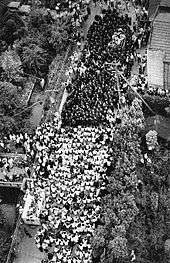Sunagawa Struggle

The Sunagawa Struggle (Japanese: 砂川闘争, also romanized as "Sunakawa") was a series of protests in Japan, starting in 1955 and continuing until the early 1960s, against the expansion of the Tachikawa Airfield into the nearby village of Sunagawa.
On May 4, 1955, an official from the Tachikawa branch of the Tokyo Procurement Office approached the mayor of Sunagawa to inform him of plans to expand the runaway of the airfield to accommodate larger aircraft. The result of an order from officials of the American-occupied base, it would have involved the eviction of 140 families. This, as well as increasing anti-base sentiment resulted in opposition by the residents of Sunagawa. Families blocked government land surveyors and their vehicles. The locals formed the Sunagawa Anti-Base Expansion Alliance, which also came to include regional and national labor unions, student groups, and Socialist Diet members. The barricades resulted in more police being sent in, causing the movement to grow larger. In October 1956, 2,000 police officers, trying to evict the farmers, fought with 6,000 protesters, resulting in 1,000 people injured. On July 8, 1957, in an event known as the Sunagawa Incident (砂川事件), some protestors infiltrated the base, and seven of them were arrested and charged with trespassing. In the 1959 Sunagawa Case (Sakata v. Japan), the Tokyo District Court initially found the U.S. bases as well as the U.S.–Japan Security Treaty unconstitutional and exonerated the protestors. However, the decision was overturned by the Supreme Court.
In 1968, the U.S. military announced the cancellation of the expansion, and in 1977, the base was returned to Japanese sovereignty.[1]
See also
References
| Wikimedia Commons has media related to Sunagawa struggle. |
- ↑ Wright, Dustin. "'Sunagawa Struggle' ignited anti-U.S. base resistance across Japan". The Japan Times. Retrieved 22 January 2016.